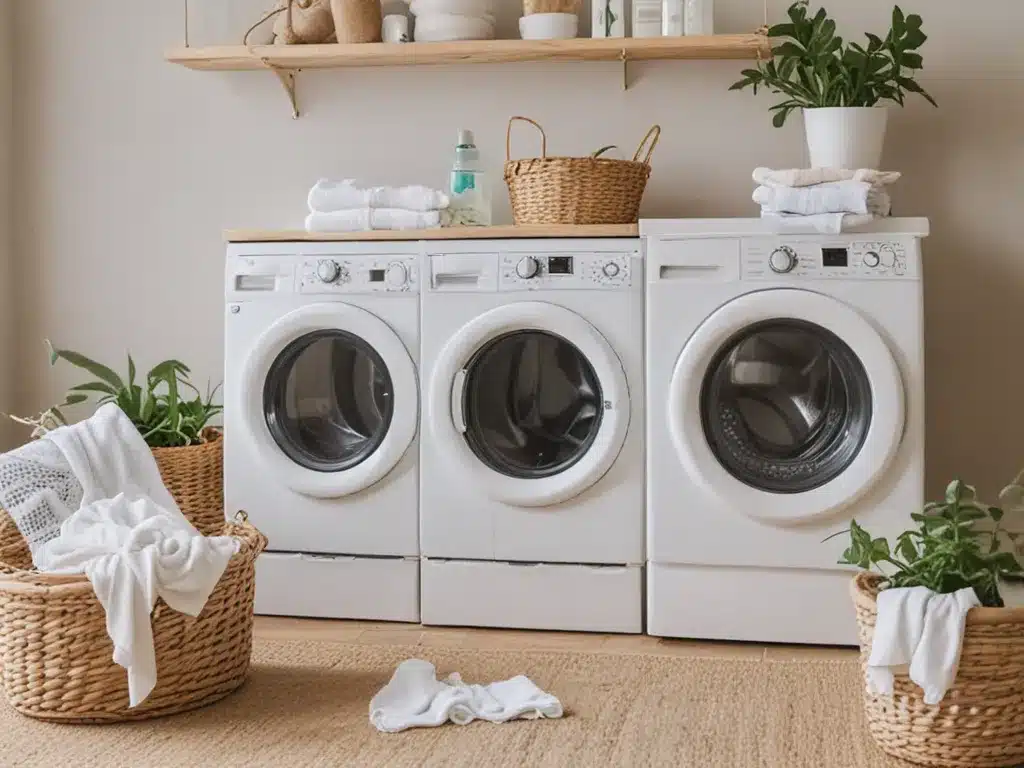Introduction
Doing laundry is an essential household task, but it can have a significant environmental impact. Fortunately, there are many simple ways to make your laundry routine more sustainable. As a conscious consumer looking to live a greener lifestyle, I am always seeking out eco-friendly laundry solutions. In this article, I will provide tips for sustainable laundry practices that have worked well for me. My goal is to clean clothes effectively while reducing water waste, energy use, and exposure to harsh chemicals. With a few easy habit changes, you can wash clothes responsibly and tread more lightly on the planet.
Reduce Water Usage
The first area I target when greening my laundry routine is water conservation. Washing machines use immense amounts of water, especially older top-loading models. Here are some techniques I rely on to slash my water usage:
Wash Full Loads
- I always make sure to have full loads before running my washing machine. This way, the same amount of water is used to clean more items. It’s inefficient to wash just a couple shirts or a handful of socks. I wait until I have enough dirty clothes to fully load the machine.
Use Shorter Cycles
- Most washers have variable cycle options ranging from delicate to heavy duty. Whenever possible, I choose the shortest appropriate cycle for each load. The lighter cycles use less water. I reserve the heavy duty setting for heavily soiled loads only.
Invest in Efficient Appliances
- When buying a new washer, look for ** ENERGY STAR certification. These appliances are designed to use significantly less water and energy than conventional models. Also consider front-loading washers**, which use less water than top-loaders.
Reuse Washer Water
- I installed gray water hoses to pump used washing machine water outside to water plants. This simple setup prevents thousands of gallons of water from going down the drain.
Use Green Cleaning Products
The second key component of my eco-friendly laundry routine is avoiding toxic chemicals found in many conventional laundry detergents, bleaches, and fabric softeners. Here are some tips for green cleaning:
Try Natural Detergents
- There are now many plant-based, biodegradable detergents on the market made from ingredients like soapnuts, coconut oil, and essential oils. These get clothes clean without chlorine bleach or artificial fragrances.
Use Baking Soda
- For a totally natural boost, I often add a cup of baking soda to my detergent-free wash cycles. The alkaline soda helps remove stains and odors without any harsh chemicals.
Skip Fabric Softener
- Fabric softeners contain many toxic chemicals and fragrances. I avoid these unnecessary products and dry clothes on racks or lines to prevent stiffness.
Make Your Own Cleaners
- It’s easy to DIY non-toxic laundry solutions using ingredients like vinegar, lemon, and hydrogen peroxide. Homemade cleaners work great at fighting stains and smells while protecting the environment.
Wash in Cold Water
The third pillar of my eco-friendly laundry process is using cold water cycles whenever possible. Heating water accounts for 90% of a washer’s energy use. Here are my tips for washing in cold:
Install a Cold Water Line
- I added a dedicated cold water hookup for my laundry room. This makes tap cold water immediately available for washing, eliminating the need to heat from a warm baseline.
Use Detergent Made for Cold Water
- Special cold water detergents contain enzymes and surfactants that enable cleaning in low temperatures. I switched products and have been very pleased with the results.
Wash Delicates in Cold
- Nearly all modern fabrics can be safely washed in cold water. I use this setting for most loads, reserving warm for heavily soiled items only. Cold water cleans just as effectively for day to day laundry.
Check Labels Before Washing
- If washing a new or delicate item, I always verify the care label recommendations first. Some fabrics and dyes require warm water. But 75% of my clothes are washed in cold.
Line Dry When Possible
The final step I take to lean up my laundry impact is line drying clothes whenever feasible. Skipping the dryer on sunny days has multiple environmental benefits:
Save Electricity
- Clothes dryers use a tremendous amount of electricity to power the drum and heating element. I line dry several loads per week, which has cut my energy bill significantly.
Less Wear on Fabrics
- The heat and tumbling action of dryers breaks down fabrics more quickly. Line dried items maintain their color and integrity longer.
Prevent Excess Lint
- Wet clothes shed more lint when machine dried. Line drying has reduced the lint buildup in my ducts and filter, improving dryer function.
Fresh Outdoor Scent
- Hanging laundry outdoors infuses clothes with the freshness of air and sunlight. This natural scent can’t be replicated by dryer sheets or fabric softeners.
Making these sustainable switches has allowed me to slash the environmental impact of my laundry without sacrificing cleanliness. I’m able to wash clothes using far less water, energy, and chemicals. With a few habit tweaks, you can easily green your own laundry routine and help preserve the planet. Our small actions add up, so start implementing eco-friendly solutions today!







